初中时间状语从句语法及练习(全)
2021年初中英语语法:时间状语从句解析和练习题(含答案)

2021年初中英语语法:时间状语从句解析和练习题(含答案)在句子中起时间状语作用的句子称为时间状语从句。
时间状语从句可以放在句首、句中和句尾。
引导时间状语从句的词有when、while、as、before、after、since、until/till、as soon as、once、each time、next time、the moment、immediately、instantly等。
(一)when引导的时间状语从句1)when意为“当......时”,引导时间状语从句,表示主句的动作和从句的动作同时或先后发生例句:Faith is the bird that feels the light when the dawn is still dark. 信念是黎明前的黑夜里能感受到光明的鸟儿。
例句:When I was wandering in the street, I met her. 我在街上徘徊的时候遇到了她。
2)when引导的时间状语从句中的动词可以用延续性的=动词,也可以用终止性动词例句:He was listening to the music when I went in. 当我进去的时候,他正在听音乐。
例句:I will visit my parents when I have time. 我有空时会去看望我的父母。
(二)while引导的时间状语从句While引导的时间状语从句,常译为“与......同时,在......期间”,while引导的从句常用延续性动词或表示状态的动词。
例句:They rushed in while we were discussing problems. 当我们正在讨论问题时,他们冲了进来。
例句:Make hay while the sun is shining. (谚)趁热打铁。
(三)as引导的时间状语从句As引导的时间状语从句,可以表达“正当,一边一边,随着”等意思。
初中英语状语从句讲解及练习.doc
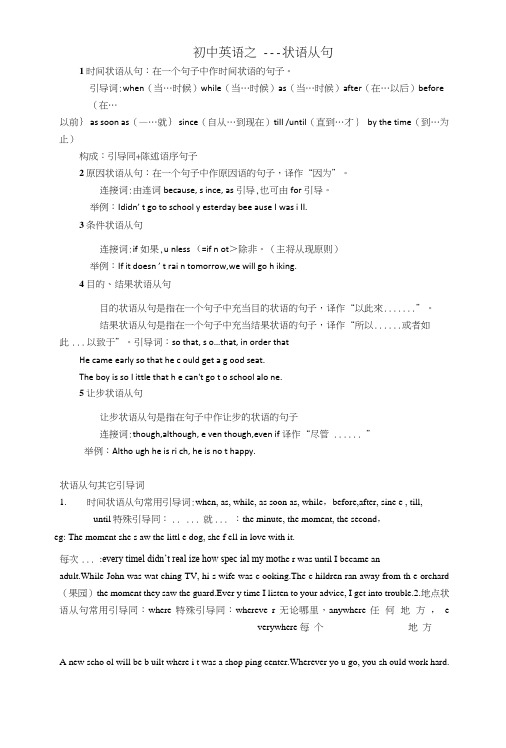
初中英语之 --- 状语从句1时间状语从句:在一个句子中作时间状语的句子。
引导词:when(当…时候)while(当…时候)as(当…时候)after(在…以后)before(在…以前} as soon as(—…就} since(自从…到现在)till /until(直到…才}by the time(到…为止)构成:引导同+陈述语序句子2原因状语从句:在一个句子中作原因语的句子,译作“因为”。
连接词:由连词because, s ince, as引导,也可由for引导。
举例:Ididn’ t go to school y esterday bee ause I was i II.3条件状语从句连接词:if如果,u nless (=if n ot>除非。
(主将从现原则)举例:If it doesn ’ t rai n tomorrow,we will go h iking.4目的、结果状语从句目的状语从句是指在一个句子中充当目的状语的句子,译作“以此來.......”。
结果状语从句是指在一个句子中充当结果状语的句子,译作“所以......或者如此... 以致于”。
引导词:so that, s o…that, in order thatHe came early so that he c ould get a g ood seat.The boy is so I ittle that h e can't go t o school alo ne.5让步状语从句让步状语从句是指在句子中作让步的状语的句子连接词:though,although, e ven though,even if 译作“尽管 ...... ”举例:Altho ugh he is ri ch, he is no t happy.状语从句其它引导词1.时间状语从句常用引导词:when, as, while, as soon as, while,before,after, sine e , till,until 特殊引导同:.. ... 就... :the minute, the moment, the second,eg: The moment she s aw the littl e dog, she f ell in love with it.每次... :every timel didn’t real ize how spec ial my mot he r was until I became anadult.While John was wat ching TV, hi s wife was c ooking.The c hildren ran away from th e orchard (果园)the moment they saw the guard.Ever y time I listen to your advice, I get into trouble.2.地点状语从句常用引导同:where特殊引导同:whereve r无论哪里,anywhere 任何地方,everywhere 每个地方A new scho ol will be b uilt where i t was a shop ping center.Wherever yo u go, you sh ould work hard.状语从句练习单项选择1.John does n't letever ybodyinthe kitchen __________ h e could makehis sur prisedinner fortheparty.A. which B. when C. so that D. as if 2.I wouldt hankit __________ you call back this a fternoon for the doctor5 smeeting.A.until B. if C. when D. that3.Asfar as Iam concerned (就我而言),education is about learning and the more you learn,—____ A. the betterlife will you get B. the betterlife you will ge tC. you will get the bet ter lifeD.will you get the bet ter life4.Af ter the war, a new school wasbuilt _____________ t here had once be en(曾经有)a theatre.A. that B. where C . which D. whe n5.—Is Mr.Smith in the office?—Yes , __________ he is in charg e of the office, he mustbe there.A.since B. how ever C. whether D. for 6.As your good friendJ will do ____________help you.A. that I can to B. what I canto C. all that I can D. what I can7.Someone called me up in the middle ofthe night, b ut they hung up(挂断电话)____________ I coul d answer the phone.A.as B.since C. until D. before8.We must hurry up __________catchup with the last train.A. that B. so that to C. in order that D. in ord er toLondon 9.No m atter ________ h ard it ma y be, I will carry it out .A. what B. whatev er C.how D. however 1 0. _________you may do, you must do itwell.A. Which B.Whenever C. What ever D.WhenM. ________ you are so weak, you’d better sta y at home.A.Since B. For C. B ecause D. Though 1 5.1saw Mr.Smith last S unday. We had not seen each other ____________ I left .A. as B. before C.since D. till 16.1’11 be back before you ________ .A.will leave B will have left C.leave D. would lea vel7.If the weather ____________ tomor row, we will go picnic i n the centra 1 park.A wil 1 be fine Bis fine Cis going to be fine D h ave been fine18. ________________________ They wen t on working it was late at night.A. eve n if B.as if C. however D. as tho ughl9.l hurr ied _____________ I wouldn't b e late for c lass.A. sine e B. sotha t C.as if D . unless20.T he volleybal I match will be put off if it __________ .A. will r ain B. rain s C. r ained D. is raining【实例解析】1.(2004年北京市海淀区中考试题)You will sta y healthy ________ you do more exerci se, such as running and walking.A.ifB. howC. beforeD. where2.(2004年江丙省中考试题)…Shall we go on wor king?Ye s, _________ I prefer to have a rest.A. whenB. ifC. be causeD. th ough3.(2004年徐州市中考试题)N one of us kn ew what had happened ___________ they told us abo ut it.A. w henB. unti IC. afterD. though4.(2004年泉州市中考试题)••-1 ho pe you’ll en joy your tri p, dear!—Thank you,mum. Til gi ve you a cal I ___________ I get there.A. untilB. as soon a sC. sinceD. till【中考演练】一.单项填空1. ______ he z s old, he c an still car ry this heav y bag.A. T houghB. Si neeC. ForD. So2.•■-Do you know if he ______ to play ba sket ball wi th us?---1 think he wi II come if h e _______ fre e tomorrow.A. comes; i sB. comes;will beC.will come;isD. will come; will b e3.In the z oo if a chil d _____ into the water a nd can't swi m, the dolph ins may come up _________ him.A. will fall; to he IpB. fall s; to helpC. will fall; help D . falls; hel ping4.1don z t remember _________ he worked in th at city when he was youn g.A. whatB. which C . where D.who5.We wil I stay at ho me if my aunt __________ to visit us t omorrow.esB. c omeC. will comeD. is coming6.Th e police ask ed the child ren _______ cross the st reet _________ the traffi c lights tur ned green.A. not; befo reB. don't; whenC. n ot to; untilD. not; af ter7.1was late for cla ss yesterday ________ t he re was somet hing wrong w ith my bike.A. when B . that C. u ntil D. bee ause8.I’ll go swimming with you if I _________ f ree tomorrow .A. will b eB. shall beC. am D . was9.In t he exam, the ________ yo u are, _______ the ________ mistakes y ou will make .A. carefu I; littleB. more ca reful; fewes tC. more c areful; fewe rD. more c a ref u I; less10.You shou Id finish yo ur lessons _______ you g o out to pal y.A. beforeB. afterC. whenD.while11.1hurried _____ I wouldn't be late for class.A.sinceB. s o thatC. a s ifD. uni ess12.When you read the book, you'd better make a mark ________ you have any questio ns.A. whi chB. thatC. where D . though13.The teacher raised his v oice ________ a ll the stu dents could hear him.A. forB. s o thatC. b ecauseD. i n order14.H e took off h is coat ________ h e felt hot.A. be causeB. asC. ifD.since15.It is ______ th at we'd like to go out f or a walk.A. a lovely dayB. t oo lovely a dayC. so lovely a dayD. such Io vely a day16 . Mary had _______ m uch w ork to do th at she staye d at her off ice all day.A. suchB.soC. tooD. very17.______ I fel t very tired , I tried to finish the work.A. AlthoughB.BecauseC.AsD. As if18.______ t he day went on, the weat her got wors e.A. WithB. SinceC. WhileD.As19.______ well you c an drive, yo u must drive carefully.A. So long asB.ln order tha tC. No ma tter how D . The momentBeijing20. Write to me as soon as you _________ to.A . will get B. get C. g etting D. g ot二.根据中文意思完成下列英语句子1.不管他跟我开什麽玩笑,我都不生气。
时间状语从句讲解和练习(答案)
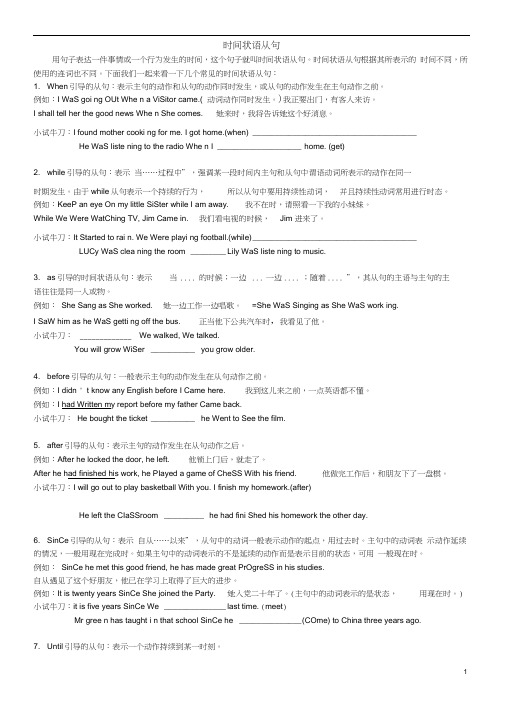
时间状语从句用句子表达一件事情或一个行为发生的时间,这个句子就叫时间状语从句。
时间状语从句根据其所表示的时间不同,所使用的连词也不同。
下面我们一起来看一下几个常见的时间状语从句:1. When引导的从句:表示主句的动作和从句的动作同时发生,或从句的动作发生在主句动作之前。
例如:I WaS goi ng OUt Whe n a ViSitor came.( 动词动作同时发生。
)我正要出门,有客人来访。
I shall tell her the good news Whe n She comes. 她来时,我将告诉她这个好消息。
小试牛刀:I found mother cooki ng for me. I got home.(when) _____________________________________ He WaS liste ning to the radio Whe n I ___________________ home. (get)2. while引导的从句:表示当……过程中”,强调某一段时间内主句和从句中谓语动词所表示的动作在同一时期发生。
由于while从句表示一个持续的行为,所以从句中要用持续性动词,并且持续性动词常用进行时态。
例如:KeeP an eye On my little SiSter while I am away. 我不在时,请照看一下我的小妹妹。
While We Were WatChing TV, Jim Came in. 我们看电视的时候,Jim 进来了。
小试牛刀:It Started to rai n. We Were playi ng football.(while) _____________________________________ LUCy WaS clea ning the room ________ Lily WaS liste ning to music.3. as引导的时间状语从句:表示当.... 的时候;一边... 一边.... ;随着.... ”,其从句的主语与主句的主语往往是同一人或物。
初中时间状语从句语法及练习教案资
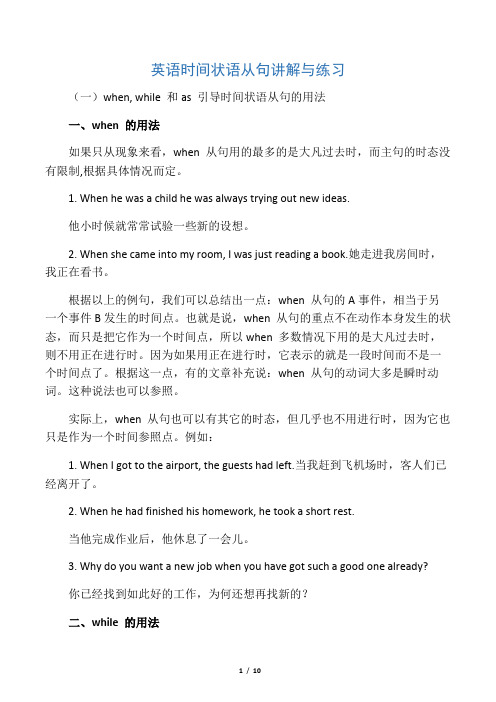
英语时间状语从句讲解与练习(一)when, while 和as 引导时间状语从句的用法一、when 的用法如果只从现象来看,when 从句用的最多的是大凡过去时,而主句的时态没有限制,根据具体情况而定。
1. When he was a child he was always trying out new ideas.他小时候就常常试验一些新的设想。
2. When she came into my room, I was just reading a book.她走进我房间时,我正在看书。
根据以上的例句,我们可以总结出一点:when 从句的A事件,相当于另一个事件B发生的时间点。
也就是说,when 从句的重点不在动作本身发生的状态,而只是把它作为一个时间点,所以when 多数情况下用的是大凡过去时,则不用正在进行时。
因为如果用正在进行时,它表示的就是一段时间而不是一个时间点了。
根据这一点,有的文章补充说:when 从句的动词大多是瞬时动词。
这种说法也可以参照。
实际上,when 从句也可以有其它的时态,但几乎也不用进行时,因为它也只是作为一个时间参照点。
例如:1. When I got to the airport, the guests had left.当我赶到飞机场时,客人们已经离开了。
2. When he had finished his homework, he took a short rest.当他完成作业后,他休息了一会儿。
3. Why do you want a new job when you have got such a good one already?你已经找到如此好的工作,为何还想再找新的?二、while 的用法相比于when 来说,while 从句的侧重点就不一样了。
while 从句的侧重点在于描述动作正在发生的状态,它的意思是:当while 事件正在发生的时候,另一件事如何如何。
时间状语从句(含练习及答案)

以when 引导的时间状语从句- When I got home, my son had finished his homework. (主句动作发生在从句之前)- When(当...时候, 主语+did) we arrived, it was raining.- When(正当...时候,主语+be+doing) I was playing the computer games, my mum came in. - He is always nervous when he speaks to strangers.- I usually walk to school when it rains.以while 引导的时间状语从句- While I was reading, my brother was playing with his toy cars. (主从句子动作同时发生)- While/When/As he was studying in the library, I saw him. (表示一段时间时,while/when/as 可替换)while引导的从句的谓语动词必须是持续性动作:I saw him while(x) I was getting off the bus.(x)I saw him when/as I was getting off the bus.以as 引导的时间状语从句- He will grow wiser as he grows older. 随着年龄的增长,他会聪明起来。
(随着,表示时间的推移,这时,不用when/while)- He entered the room as/when/while the meeting was going on. 正当开会的时候,他走进房间。
以before引导的时间状语从句- He had washed his hands before he had dinner. (主句动作先于从句动作)- Please clean the house before you move in.以after 引导的时间状语从句- She went on holiday after she had taken the examination. (从句动作先于主句)- You can watch TV after you finish your homework.以since 引导的时间状语从句- She has been in the house since she came to the city. (主句完成时态,从句过去时)- I have taught them English since last year.以as soon as引导的时间状语从句- I will write to you as soon as I get to America. 我一到美国就会给你写信。
英语时间状语从句讲解与练习(完整版)

英语时间状语从句讲解与练习英语时间状语从句讲解与练习when, while 和 as 引导时间状语从句的用法这三个词的意思很简单,都有“当……时候”的意思。
但学生经常会问三个词的区别在哪儿,特别是在做选择题的时候。
别说是学生,就我个人而言,做这样的选择题要保证百分之百的正确也是不可能的。
现根据大量的实例和个人的思考,做一点小结,供大家参考。
一、when 的用法如果只从现象来看,when 从句用的最多的是一般过去时,而主句的时态没有限制,根据具体情况而定。
1. When he was a child he was always trying out new ideas. 他小时候就常常试验一些新的设想。
2. When she came into my room, I was just reading a book. 她走进我房间时,我正在看书。
3. Were you writing when the teacher came in 老师进来的时候,你在写信吗?4. Sorry, I was out when you called me. 对不起,你打电话来的时候我出去了。
5. He was on the point of leaving when someone knocked at the door. 他正要走,这时有人敲门。
6. I thought of it just when you opened your mouth. 就在你要说话的时候,我也想到了。
7. I had hardly[scarcely] closed my eyes when someone knocked at the door. 我刚一闭上眼,就有人在敲门了。
根据以上的例句,我们可以总结出一点:when 从句的A事件,相当于另一个事件B发生的时间点。
也就是说,when 从句的重点不在动作本身发生的状态,而只是把它作为一个时间点,所以when 多数情况下用的是一般过去时,则不用正在进行时。
时间状语从句及其练习题

状语从句一、时间状语从句一、时间状语从句 1、 as soon as “一、、、、、、就、、、、、、”引导时间状语从句的连词有引导时间状语从句的连词有The moment immediately The minute directly He instant instantly No sooner than Hardly had sb , done done…… when ….did ….. Scarcely when The moment she comes, I’I’ll call you. ll call you. She left immediately the meeting was over. Hardly had he got off the bus when he heard a loud noise. 2、 when ,while , as 引导时间状语从句引导时间状语从句时间点时间点 段时间段时间 区 别 When 主从同时;先后主从同时;先后 While 主从同时主从同时 对比对比 As 主从同时主从同时(一边、、、一边)、一边)It was raining when we arrived. My mother came in when I was doing my homework. While /when I was doing my homework, my mother came in. I am safe while I am here. He hurried home, looking behind as he went. As I left the house, I forgot the key. 主从句时态主从句时态Will you please bring me your book when you come here tomorrow? I will go home when I have finished my work . When / while 连词引导并列句连词引导并列句Was/ were about to do …Was /were going to do …. Was/were on one ’s way …Was .were on the point of doing …. When …. Was/were doing Was/were doing……. (“这时” 表同时) Had done …Jasmine was holidaying holidaying with with with her her her family family family in in in a wildlife a wildlife park when she w as was was bitten bitten bitten on on on the the the leg leg leg by by by a a lion. ………….while .while ………….(.(“然而”“然而” 表反比) I do every single bit of housework while my husband Bob just does the dishes now and then. 3、before 引导时间状语从句引导时间状语从句1)“还没等”(谓语不用否定式)(谓语不用否定式)Before they got to the bus stop, the bus had gone. 2) “….. (之后)才/就”It was evening before we reached the little town of Winchester. 3)固定句型:固定句型: It will (not) be some time before …………do do …… It was (not) some time before ….did ….. It won ’t be long before …………dodo do............ It wasn ’t long before (i)did did…….. 4 . until /till ( till 不用于句首或强调句)不用于句首或强调句) 引导时间状语从句引导时间状语从句1)…..not ….until/till .until/till……直到……才 He didn ’t go to bed until he had finished his work 2) …...until …...until /till /till …..直到……为止为止We were told that we should follow the main road until we reached the railway station . 3)强调句式强调句式It is not until …that … It was not until midnight that he went back home after the experiment. 4) not until 放在句首时,主句半倒装。
初中英语状语从句练习

初中英语状语从句练习状语从句是英语中用来修饰动词、形容词、副词或整个句子的从句。
它们可以提供时间、地点、原因、条件、让步等信息。
下面是一些练习题,帮助你更好地理解和使用状语从句。
一、时间状语从句1. When you finish your homework, you can go out to play. - 完成作业后,你可以出去玩。
2. As soon as he arrived, he started working.- 他一到达就开始工作。
二、地点状语从句1. Wherever you go, make sure to call your parents.- 不管你去哪里,都要确保给你的父母打电话。
2. I will sit where I can see the stage clearly.- 我会坐在能够清楚看到舞台的地方。
三、原因状语从句1. Because it was raining, the match was postponed.- 因为下雨,比赛被推迟了。
2. Since you are not feeling well, you should rest.- 既然你感觉不舒服,你应该休息。
四、条件状语从句1. If you study hard, you will pass the exam.- 如果你努力学习,你会通过考试。
2. Unless you apologize, I won't forgive you.- 除非你道歉,否则我不会原谅你。
五、让步状语从句1. Although he is old, he is still very active.- 尽管他年纪大了,但他仍然非常活跃。
2. Even though she was tired, she continued working.- 即使她很累,她还是继续工作。
六、结果状语从句1. He ran so fast that he caught the bus.- 他跑得如此快,以至于赶上了公交车。
【语法专项训练】状语从句翻译专项练习及答案
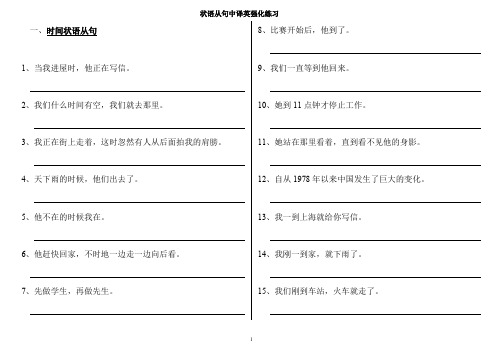
一、时间状语从句1、当我进屋时,他正在写信。
2、我们什么时间有空,我们就去那里。
3、我正在街上走着,这时忽然有人从后面拍我的肩膀。
4、天下雨的时候,他们出去了。
5、他不在的时候我在。
6、他赶快回家,不时地一边走一边向后看。
7、先做学生,再做先生。
8、比赛开始后,他到了。
9、我们一直等到他回来。
10、她到11点钟才停止工作。
11、她站在那里看着,直到看不见他的身影。
12、自从1978年以来中国发生了巨大的变化。
13、我一到上海就给你写信。
14、我刚一到家,就下雨了。
15、我们刚到车站,火车就走了。
16、我们刚开始就被叫停。
17、我每次乘船都晕船。
18、我一听到这首歌,就感到很愉快。
19、下次你来的时候,就会见到他。
二、地点状语从句1、有志者,事竟成。
2、哪里有水,哪里就有生命。
3、你可以随意到你喜欢的任何地方去。
4、无论你去哪都要遵守法律。
三、原因状语从句1、昨天我回来晚了,因为我值班。
2、既然大家都到了,我们开始开会。
3、由于他英语懂得不多,他在字典中查阅这个单词。
4、鉴于天气已经晴朗,我们可以启程了。
5、鉴于他病情严重,我们派人去请医生去了。
四、目的状语从句1、我要把你的电话号码记下来,以免忘记。
2、我把真实情况告诉你,使你能自己作出判断。
3、他们比往常更加努力工作,为了能提前完成工作。
4、多穿点衣服,以免患感冒。
五、结果状语从句1、我们把收音机的音量放大,大家都听到了新闻。
2、他十分激动,以致一句话都说不出来。
3、他说出了这么重要的理由,得到大家的谅解。
4、这是一本十分有意思的书,大家都想看。
六、条件状语从句1、如果我们不怕困难,困难就算不了什么了。
2、除非下雨,我们明天就去那里。
3、只要你努力工作,你就一定能成功。
4、万一我忘了,请提醒我一下。
5、据我所知,那本书下月出版。
七、方式状语从句1、按照我教你的画一只猫。
2、按照人家告诉你做的去做。
3、看上去她好象是生病了。
4、他的行动就好象什么也没有发生。
中考英语语法专题 时间状语从句讲解+练习

时间状语从句常用引导词:when, while, as, as soon as, before, after, till/until, since1、when, while, as(1)三者均可表示“当……时候”,如果主句表示的是短暂的动作,而从句表示的是一段时间,三者可通用。
如:I met Kang Li while/when/as I was walking along the street.当我沿街散步时碰见了康丽。
Don’t make any noise while/when/as I am recording. 我录音时(你们)别发出声音。
(2)while1)while只能与持续性动词连用,且常用进行时态。
表示主句的行为在从句行为进行的过程中发生。
如:While they were crossing the Atlantic, many people died. 他们中的很多人在横渡大西洋时丧生了。
2)表示主句和从句的动作同时发生。
如:While the wife was cooking, the husband was watching TV. 妻子在做饭的时候,丈夫在看电视。
3)表示“然而”,主句和从句是两个对应的动作。
如:Lucy likes dancing while Lily likes doing sports. 露西喜欢跳舞而莉莉喜欢运动。
(3)when1)when既可以和持续性动作连用,也可以和瞬间性动作连用,主句与从句描述的动作既可以同时发生,也可以先后发生。
如:When the weather is fine, many people go out for a walk. 天气好时,很多人都出去散步。
When I got home, I found my baby girl singing in the sitting room. 我到家时,发现我的小女儿正在客厅里唱歌。
(完整版)初中时间状语从句语法及练习

英语时间状语从句讲解(一)when, while 和as 引导时间状语从句的用法一、when 的用法如果只从现象来看,when 从句用的最多的是一般过去时,而主句的时态没有限制,根据具体情况而定。
1. When he was a child he was always trying out new ideas.3. Were you writing when the teacher came in? 老师进来的时候,你在写信吗?4. Sorry, I was out when you called me. 对不起,你打电话来的时候我出去了。
when 从句的重点不在动作本身发生的状态,而只是把它作为一个时间点,所以when 多数情况下用的是一般过去时,则不用正在进行时。
因为如果用正在进行时,它表示的就是一段时间而不是一个时间点了。
根据这一点,有的文章补充说:when 从句的动词大多是瞬时动词。
这种说法也可以参照。
实际上,when 从句也可以有其它的时态,但几乎也不用进行时,因为它也只是作为一个时间参照点。
例如:2. When he had finished his homework, he took a short rest.3. Why do you want a new job when you have got such a good one already?二、while 的用法相比于when 来说,while 从句的侧重点就不一样了。
while 从句的侧重点在于描述动作正在发生的状态,它的意思是:当while 事件正在发生的时候,另一件事如何如何。
所以,while 从句一般用的是正在进行时。
而另一件事的状态没有硬性的要求,根据具体情况而定。
例如:1. While my wife was reading the newspaper, I was watching TV.2. While Jim was mending his bike, Lin Tao came to see him.3. While they were talking, the bell rang. 正在他们谈话的时候,上课铃响了。
时间状语从句及练习

时间状语从句常见的从属连词有:(注意其汉语意义)when, while, as, before, after, since, until (till) once as soon as, the moment, the minute, immediately, directly, each/every time, the first time, the last time, next time, by the time, whenever等。
例如:Every/Each time I was in trouble, he would come to my help.I thought her nice and honest the first time I met her.注意:(1)when, while, as的区别:1)when引导从句时,主从句的动作有先有后,也可以同时进行,从句的动作可以是持续性的,也可以是短暂的。
如:When I got to the airport, the plane had already taken off. (主先从后)(短暂性)When I lived there, I used to go to the seaside on Sundays. (同时) (持续性)When the movie ended, the people went back. (从先主后)2)while侧重主从句动作的对比,且从句的动词必须是持续性的。
如:While we were chatting she was looking at the time table on the wall.3)as引导从句时侧重主从句动作同时或几乎同时进行,从句的动作可以是持续性的,也可以是短暂的。
如:Sometimes I watch TV as I am having breakfast.4)when和while还可以是并列连词,意思分别是“就在这时”,“然而”。
(完整版)初中时间状语从句语法及练习(全)

状语从句什么是状:句子中修、形容等的句子成分叫状,用来从地点、、原因、目的、果、条件、步、比、方式和陪同情况等方面修明。
e.g. He speaks English very well(.副作状)e.g. He is playing under the tree(.介短作状)e.g. I come specially to see you(.不定式作状)e.g. If I am not busy tomorrow,I will play football with you.(从句作状)e.g. Having had a quarrel with his wife,he left home in a bad temper(.分作状)状从句:状从句就是在复合句里起状作用的从句,能够表示、地点、原因、目的、果、步、比、方式、条件等。
引状从句的叫做隶属。
状从句的位置能够在句首,也能够在句末。
放在句首,从句后边常用逗号与主句分开;放在句末,从句前面常常不用逗号。
If it ’ s fine tomorrow, I wilgo with you.I will go with you if it’ s fine tomorrow.状从句分:1、状从句2、地点状从句3、原因状从句4、目的状从句5、果状从句6、条件状从句7、步状从句8、比状从句9、方式状从句状从句隶属:when, while, as, before, after, till/until, since, whenever, as soon as(一⋯⋯就)⋯⋯:主将从,主情从,主祈从一、 When/while/as (当⋯候)区:主句作与从句作生的(同/以前 /此后);从句(延性 /瞬性)1)When:when 引状从句表示“当⋯⋯ 的候”,when既能够指段也可指点,从句中既可用延性又可用瞬性,且作既可和主句的作同生又可在主句的作以前或此后生。
且when 引的状从句中一般用一般在表将来(主将从)。
初中英语状语从句详细讲解与练习(精华版)

对比训练 1
1. __A__ he heard this, he got very angry.
2. I met Lucy__B__ I was walking along the river.
3. __C__ a child, he lived in the countryside. A. when B. while C. as
4. 表示“随着…..”.常指一个行为是另一个行为的结果。 As she grew older, she became more beautiful.
while:持续性动词 /进行时
1.一般或现在情况
e.g. I like listening to music while I am doing my homework 2.将来. 情况-V一般现在时或现在进行时 e.g.— I’m going to the post office.
won in the end.
A. After B. before C. when D. then
since引导的时间状语从句
1.常译为“自从……”, 2.主句常用现在完成时,从句常用一般过去时。
1.我们自从分手以后一直没见过面。 We haven’t seen each other since we parted. 常用句型:It has been (is) + 时间段 + since从句
-- While you are there, can you get some stamps for me?
3.过去情况
e.g. I hurt my should while I was doing gym.
When: 1.当…的时候 When I was young, I went to town myself. When he receives the letter, he’ll tell us.
时间状语从句+习题练习(含答案)
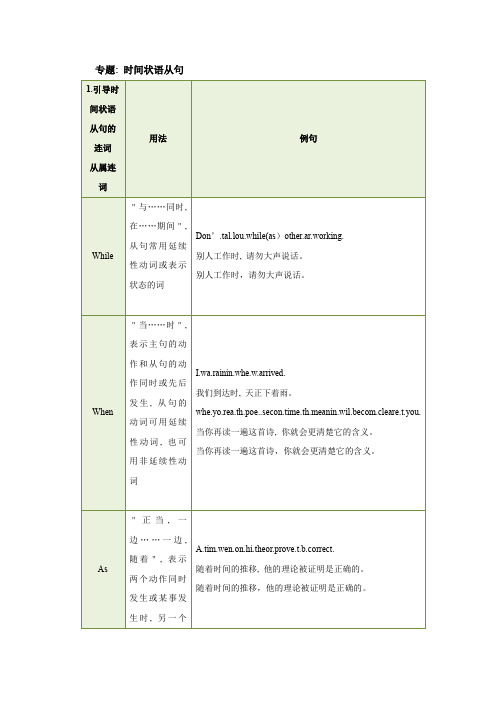
专题: 时间状语从句在下列空格中填入适当连词。
1._________he comes tomorrow,I will ask where he has been.2._________he was speaking,everybody listened carefully.3.I saw her just now_________she was getting off the train.4.Have a good look at that man________you pass him.5.It was already eight o'clock_________we got there.6.I was about to go out_________a visitor came.7.We'll go to the country at the beginning of June,_________the summer harvest will start.8.He learned to speak German_________he was in Berlin.9.Henry is in charge of the office________Mr.Smith is away.10.I listen to the recorder_________I have time.11.He had learned Chinese_________he came to China.12._________the work was done,we sat down to sum up experience.13.I haven't seen him_________he moved to the other side of the town.14.I waited________ he came back.15.I didn’t recognize him________he took off his eyeglasses.16.She likes everything to be in place________she starts to work.17.The thieves ran away_________they caught sight of the police.18.They decided to go back home_________their money ran out.19.__________I get to the airport,I will phone you to pick me up.20.They were about to leave______it began to rain.Keys:1.When2.While/When3.as4.when/as5.when6.when7.when8.while9.whi le10.whenever11.before12.After13.since14.till/until15.until16.before17.as soon as18.before19.As soon as20.when。
时间状语从句讲解和练习(答案)

时间状语从句用句子表达一件事情或一个行为发生的时间,这个句子就叫时间状语从句。
时间状语从句根据其所表示的时间不同,所使用的连词也不同。
下面我们一起来看一下几个常见的时间状语从句:1.when引导的从句:表示主句的动作和从句的动作同时发生,或从句的动作发生在主句动作之前。
例如:I was going out when a visitor came. (动词动作同时发生。
)我正要出门,有客人来访。
I shall tell her the good news when she comes.她来时,我将告诉她这个好消息。
小试牛刀:I found mother cooking for me. I got home.(when)_______________________________________ He was listening to the radio when I home. (get)2.while 引导的从句:表示“当……过程中”,强调某一段时间内主句和从句中谓语动词所表示的动作在同一时期发生。
由于while从句表示一个持续的行为,所以从句中要用持续性动词,并且持续性动词常用进行时态。
例如:Keep an eye on my little sister while I am away.我不在时,请照看一下我的小妹妹。
While we were watching TV, Jim came in. 我们看电视的时候,Jim进来了。
小试牛刀:It started to rain. We were playing football.(while)_______________________________________ Lucy was cleaning the room Lily was listening to music.3.as引导的时间状语从句:表示“当……的时候;一边……一边……;随着……”,其从句的主语与主句的主语往往是同一人或物。
- 1、下载文档前请自行甄别文档内容的完整性,平台不提供额外的编辑、内容补充、找答案等附加服务。
- 2、"仅部分预览"的文档,不可在线预览部分如存在完整性等问题,可反馈申请退款(可完整预览的文档不适用该条件!)。
- 3、如文档侵犯您的权益,请联系客服反馈,我们会尽快为您处理(人工客服工作时间:9:00-18:30)。
状语从句什么是状语:句子中修饰动词、形容词等的句子成分叫状语,用来从地点、时间、原因、目的、结果、条件、让步、比较、方式和伴随状况等方面修饰说明谓语。
e.g. He speaks English very well.(副词作状语)e.g. He is playing under the tree.(介词短语作状语)e.g. I come specially to see you.(不定式作状语)e.g. If I am not busy tomorrow,I will play football with you.(从句作状语)e.g. Having had a quarrel with his wife,he left home in a bad temper.(分词作状语)状语从句:状语从句就是在复合句里起状语作用的从句,可以表示时间、地点、原因、目的、结果、让步、比较、方式、条件等。
引导状语从句的连词叫做从属连词。
状语从句的位置可以在句首,也可以在句末。
放在句首时,从句后面常用逗号与主句隔开;放在句末时,从句前面往往不用逗号。
If it’s fine tomorrow, I wil l go with you.I will go with you if it’s fine tomorrow.状语从句分类:1、时间状语从句2、地点状语从句3、原因状语从句4、目的状语从句5、结果状语从句6、条件状语从句7、让步状语从句8、比较状语从句9、方式状语从句时间状语从句从属连词:when, while, as, before, after, till/until, since, whenever, as soon as(一……就)……时态:主将从现,主情从现,主祈从现一、When/while/as(当…时候)区别:主句动作与从句动作发生的时间(同时/之前/之后);从句动词(延续性/瞬时性)1)When:when引导时间状语从句时表示“当……的时候”,when既可以指时间段也可指时间点,从句中既可用延续性动词又可用瞬间性动词,且动作既可和主句的动作同时发生又可在主句的动作之前或之后发生。
且when引导的时间状语从句中一般用一般现在时表将来(主将从现)。
e.g. I will call you when I get there.e.g. When I came home my wife was cooking dinner.e.g. I will go home when the rain stops.e.g. When I got to the airport,the guests had left.A)如果when引导的时间状语从句的主语与主句主语相同,而从句的谓语又是be动词时,那么从句中的主语和be可以省略;e.g. When (you are) in trouble, ask her for help.B)当when引导的时间状语从句的主语与主句主语相同时,往往还可以省略从句的主语并用“when+分词”的形式替代该状语从句。
e.g. When I came into the room (=When coming into the room), I found him lying there asleep.2)Whilewhile引导时间状语从句时表示“当……的时候”,它强调主句的动作与从句的动作同时持续地进行,用于这一用法时while引导的时间状语从句和主句中的谓语动词必须是延续性动词,或者强调主句的动作发生在从句动作的进行过程中,此时主句中的谓语动词通常是非延续性动词。
记住,从句中始终是延续性动词,且从句多用进行时态。
(while 还可以表示对比,译成“然而”,放在句首可以表示“虽然”)e.g. I met her while I was at school.e.g. While I was sleeping, the UFO arrived.e.g. We were doing our homework while it was raining outside.e.g. Study while you study; play while you play.3)Asas引导时间状语从句时表示①“当……时”(只引导瞬间性动词,两个动作是紧密联系的,一前一后进行),②“一边……一边……”,侧重表示两个动作同时发生(包括一个主语同时进行两个动作),③“随着”,一种动作随着另一种动作的变化而变化从句中只能接延续动词。
e.g. He jumps as he goes along.e.g. As the wind rose the noise increased.【When, while , as 辨析】三者均可以表示“当……时候”,如果主句表示的是短暂性动作,而从句表示的是延续性动作(主短从延),三者可以通用。
I met Mr Li as / when / while I was walking along the street.(1)While意为“在……期间”,从句的谓语必须是延续性动词。
The plane had left when we got to the airport.(2)表示带有规律性的“每当”,或者主从句动作有先后时,都只能用when.When winter comes, it becomes cold.(3)表示“随着”时间的推移,主从句的内容是两种变化的情况,只能用as.As the day went on, the weather got worse.(4)强调主句动作延续到从句所指的整个时间,只能用while.【巩固练习】1)I had just stepped out of the bathroom and was busily drying myself with a towel ____ I heard the steps.A. whileB. whenC. sinceD. after2)He was about halfway through his meal ____ a familiar voice came to his ears.A. whyB. whereC. whenD. while3)We were swimming in the lake ____ suddenly the storm started.A. whenB. whileC. untilD. before4)—I’m going to the post office.—____ you’re there, can you get me some stamps?A. AsB. WhileC. BecauseD. If5)I ____ along the street looking for a place to park when the accident ____.A. went; was occurringB. went; occurredC. was going; occurredD. was going; had occurred答案BCABC二、Before/afterbefore引导时间状语从句时表示主句的动作发生在从句动作之前,常翻译为在“……之前”,“……才……”或“……就……”。
e.g. See me before you leave.e.g. Before they drive any of the buses, they will have to pass a special test.after引导时间状语从句时表示主句的动作发生在从句动作之后e.g. I saw them after I arrived.e.g. I found his pen after he has left.【巩固练习】He was told that it would be at least three more months ____ he could recover and return to work.A. whenB. beforeC. sinceD. thatIt was some time ____ we realized the truth.A.whenB. untilC. sinceD. before三、Till/until/not……until1、肯定句:till和until这两个词作连词和介词时的意义和用法相同,一般可以换用(放在句首时通常用until的形式,till在口语中更为常见)。
主句的谓语动词必须是持续性的,表示“到……为止”,“直到……才(开始)”。
e.g. Walk till you come to a white house.e.g. We didn’t discuss the problem until he came back.2、否定句:Not ……until,主句的谓语动词则为短暂性的,表示“直到……才”,若主句谓语动词为延续性动词,根据上下文可表示“没有到……”He didn’t wait until/ till I returned.他没有等到我回来。
not until的三种用法:1)用在句中的基本用法e.g. He did not appear until the concert ended.2)与that搭配的强调结构e.g. It was not until the concert ended that he appeared.3)用于句首的倒装结构主句倒装e.g. Not until the concert ended did he appeared.【巩固练习】1)It is difficult for us to learn a lesson in life ____ we’ve actually had that lesson.A. untilB. afterC. sinceD. when2)A good storyteller must be able to hold his listeners’ curiosity ____ he reaches the end of the story.A. whenB. unlessC. afterD. until3)I don’t really work here; I ____ until the new secretary arrives.A. just help outB. have just helped outC. am just helping outD. will just help out四、SinceSince引导的时间状语从句表示“自从……以来”,需注意以下两1)引导时间状语从句时,一般指的是“从过去的某一时间点以来”的概念,表示动作从过去一直持续到现在。
